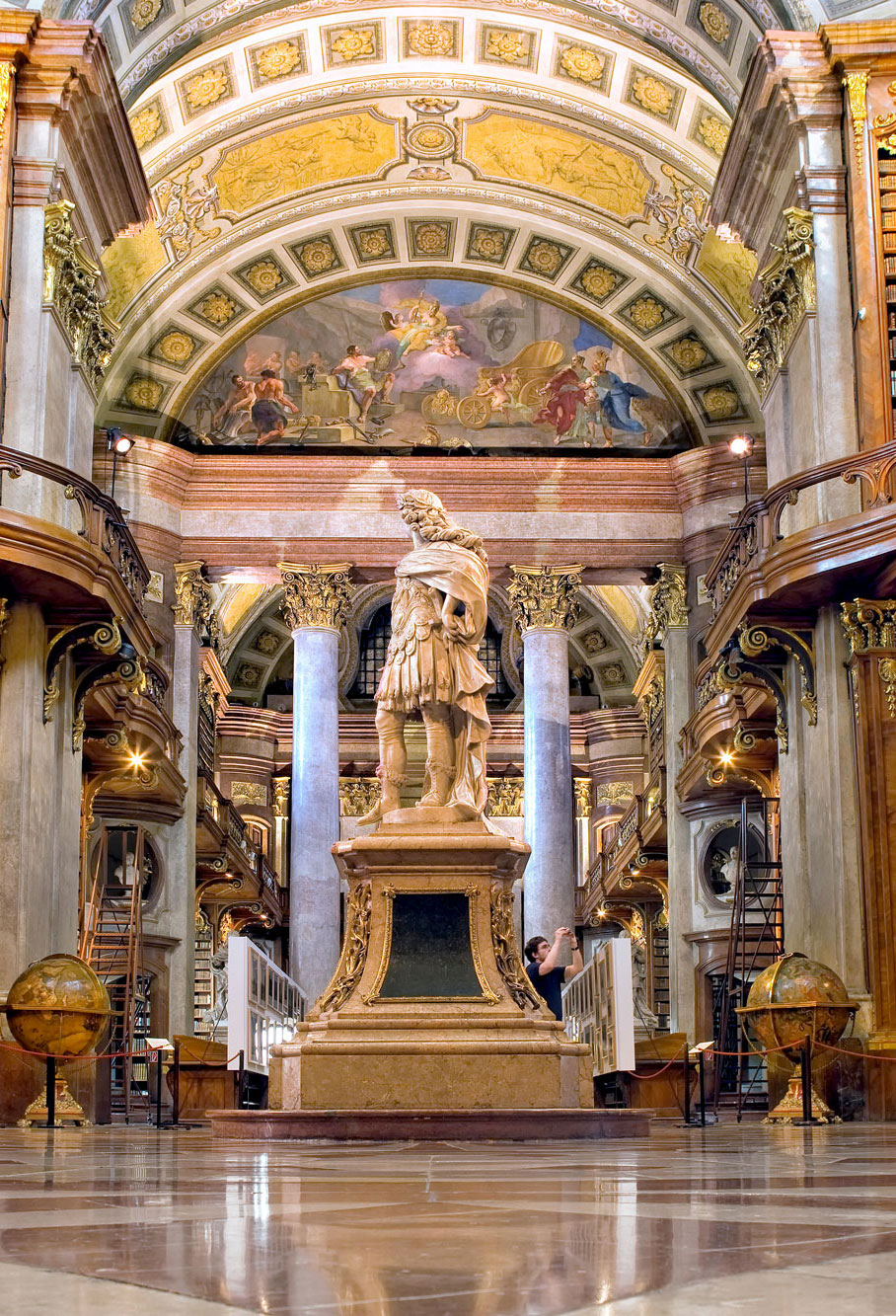For bookworms, libraries are more than just a place to borrow books. They are places of reverence, reflection, and endless fascination. The buildings they occupy are often historical landmarks and architectural marvels, from beautiful Baroque-style buildings to modern, minimalist structures. Love libraries? Get ready to swipe your library card at 20 of the world’s most beautiful libraries.
Admont Abbey Library – Admont, Austria
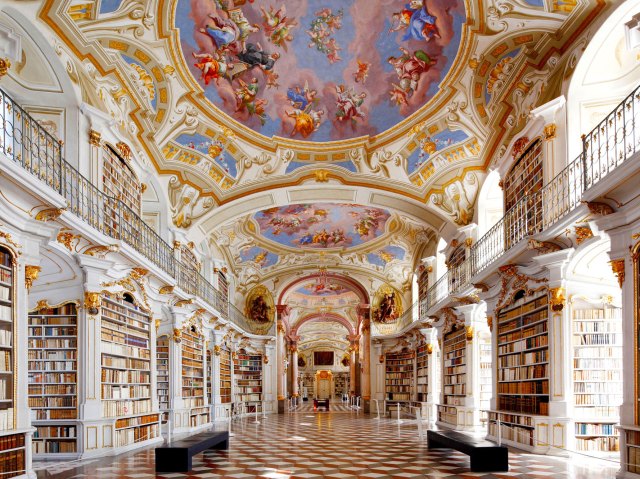
Built in 1776, this breathtaking library is housed in the Admont Abbey, a Benedictine monastery located on the Enns River in Admont, Austria. It was designed by architect Joseph Hueber and is known for its ornate, Baroque architecture, art, and of course, books. Inside, the books are almost uniformly bound in white to match the predominant interior colors of white and gold.
The dazzling hall is also accented with the peaceful pastel hues of Austrian artist Bartolomeo Altomonte’s ceiling frescoes, which represent the evolution of human knowledge. The additional ceiling features seven stunning cupolas (small, dome-like lookouts to allow light in), along with Josef Stammel’s limestone “Four Last Things” sculptures dramatically depicting death, heaven, hell, and the Last Judgement. Together, these heavenly embellishments make the Admont Abbey a one-of-a-kind work of art.
Bodleian Library – Oxford, England
Housing over 12 million printed items, Oxford University’s Bodleian Library is the second-largest library in Britain (surpassed only by the massive British Library in London). Its impressive collection — which includes rare medieval maps, a copy of the Gutenberg Bible, and even William Shakespeare’s “The First Folio” (without which some of the playwright’s most revered works would be lost) — would be enough to make it one of the most awe-inspiring libraries in the world.
But its buildings make it breathtaking in its own right. The 18th-century Radcliffe Camera building, with its majestic, circular design, is one of the most impressive structures, and also happens to be the oldest circular library in the U.K. Eagle-eyed visitors will also recognize parts of the library’s interior from several of the Harry Potter films.
Seattle Public Library – Seattle, Washington
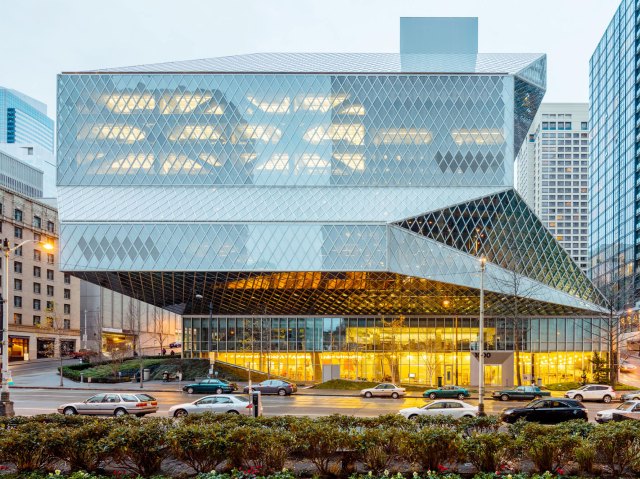
The Seattle Public Library‘s central branch stands 11 stories tall from its hilltop perch. Although it was only built in 2004, its glassy shell has become an essential part of the city’s skyline, and its interior is now a functional and flexible public space. Designed by Dutch architect Rem Koolhaas, the library’s various glass-faceted platforms allow natural sunlight inside and visitors to enjoy city views throughout the building.
Koolhaas envisioned the space as the ideal representation of a modern library, which should serve as “an information store where all potent forms of media, new and old, are presented equally and legibly.” It also happens to be one of the most Instagrammed libraries in the world.
Biblioteca Vasconcelos – Mexico City, Mexico
The stark hanging shelves — and the almost 500,000 books that adorn them — are the real standout of this industrial masterpiece in Mexico City. But the Biblioteca Vasconcelos’ bold interior design, (the brainchild of local architect Alberto Kalach) has plenty of other curiosities to discover as you walk the 409,000-square-foot “megalibrary” — the see-through glass floors create some staggering dimension to the space, and a not-so-subtle whale bone sculpture in the main lobby by artist Gabriel Orozco was inspired by the building itself. Outside, the building is beautifully integrated with a lush botanical garden, providing visitors with a tranquil oasis away from the hustle and bustle of the city.
Library of Congress – Washington, D.C.
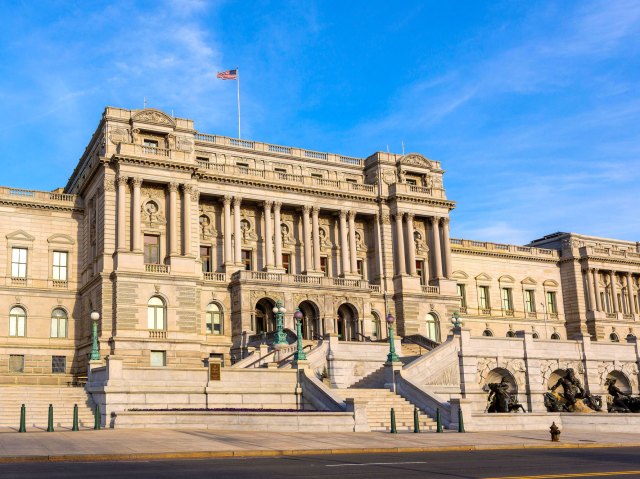
Perhaps the most famous (and beautiful) of the three buildings that make up Washington, D.C.’s Library of Congress is the Thomas Jefferson Building; it opened in 1897 and houses the iconic domed Main Reading Room, which was inspired by the reading room at the British Museum Library in London. The library’s stately, neoclassical architecture houses beautifully intricate American artworks beloved by the over 1 million tourists who visit the historic U.S. government site annually.
Not only is the Library of Congress one of the most beautiful libraries in the U.S., but it also happens to be the biggest library in the world based on shelf space and the number of materials, which tops a staggering 170 million.
Strahov Monastery Library – Prague, Czechia
Prague’s Strahov Monastery was founded in 1143 as part of the historic Clementium building complex. Over the years, the monastery endured multiple wars, a communist takeover, and other disasters until it became a library in 1679. The building’s best-known and most beloved features are the textured ceilings — especially those in the Theological Hall — adorned with biblical frescoes. Tourists also flock to the beautiful, Baroque-style library for its “compilation wheel,” a tool that makes books easier to hold while reading; its massive celestial globes; and two secret passageways reportedly hidden behind shelves that are opened by moving prop books.
Central Library – Vancouver, Canada
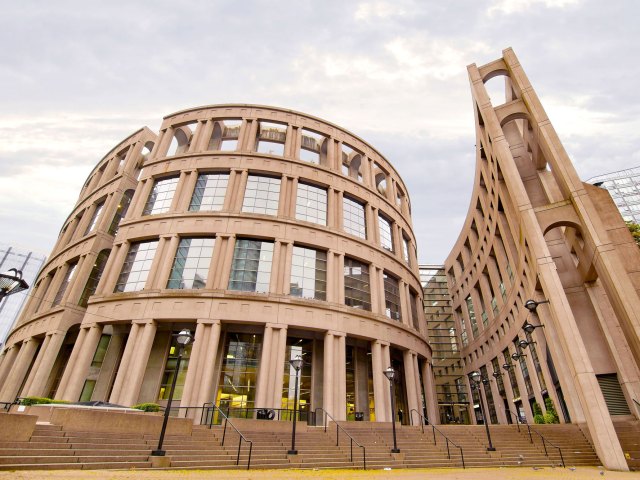
Vancouver is better known for its natural beauty than its architecture, but the Central branch of the Vancouver Public Library system is a standout structure in the western Canadian city. The downtown building was inspired by Rome’s famous Colosseum and was built after the city held a design competition. The competition was won by Safdie Architects and the library opened to great public acclaim in 1996. Inside, the spiraling space is surrounded by a multi-story colonnade and glass façades all around. At the top of the structure is a bright reading room and a spectacular, green roof that doubles as a public park.
Geisel Library – San Diego, California
The Geisel Library at the University of California – San Diego sits on the edge of a canyon near the center of campus. While the library’s setting is certainly striking, it’s the building’s arresting, geometric shape that has made it the campus’ — and one of the city’s — most iconic structures. The Brutalist-style building designed by American architect William Pereira is supported by the lower two pedestal levels, which ascend into a full six-story, stepped-glass tower reflecting the bright, blue California sky.
The library was named in honor of Audrey and Theodor Seuss Geisel (better known as children’s author Dr. Seuss) for their contributions to both the library and literacy initiatives at large. The building, perhaps unsurprisingly, houses an impressive Dr. Seuss collection that consists of original manuscript drafts, drawings, books, memorabilia, and more.
Royal Portuguese Reading Room – Rio de Janeiro, Brazil
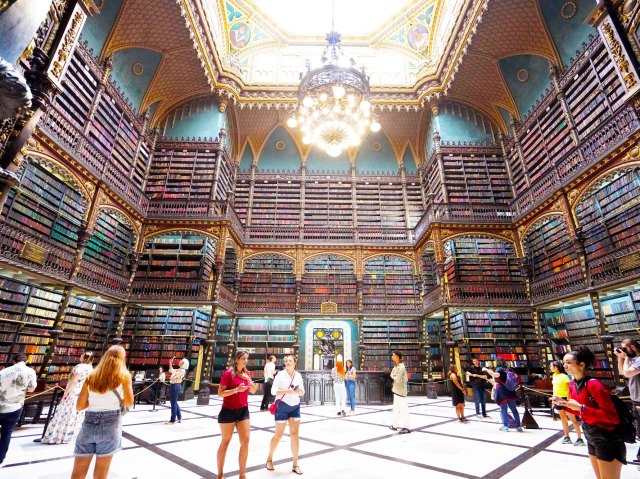
If you close your eyes and dream of the ideal library, you might just end up picturing something that looks like Rio De Janeiro’s Royal Portuguese Reading Room. Built in 1887, the limestone building features over 350,000 volumes, which line the vertical shelves that stretch as high as the vibrant, red-and-blue, stained glass skylight. The cozy space is surrounded by dark wooden arches, more stained glass, a showstopper of a chandelier, and an altar made of silver, marble, and ivory that’s fit for a royal.
Stuttgart City Library – Stuttgart, Germany
Many of the world’s most beautiful libraries are more traditional with ornate reading rooms, but the City Library in Stuttgart, Germany, makes a strong case for modern minimalism. Designed in 2011 by Cologne-based Korean architect Eun Young Yi, the building is a white concrete cube on the outside and an equally stark, stunning vision on the inside. The main reading room resembles an inverted pyramid, surrounded by white shelves that are lined with impressively tidy stacks of thousands of books.
By night, the building’s exterior turns into an oversized light sculpture, emitting a radiant, blue light and transforming the evolving cityscape that surrounds it. According to the architect, the library’s design takes cues from Noah’s Ark, the Confucian theory of concentric order, and Stanley Kubrick’s 2001: A Space Odyssey.
Royal Library – Copenhagen, Denmark
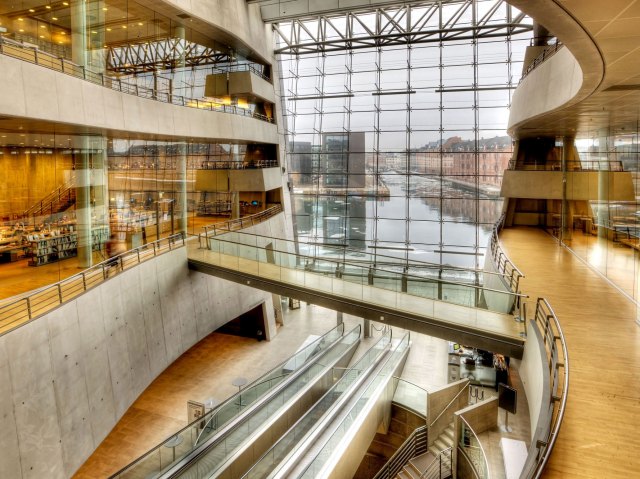
The most recognizable building on the Copenhagen waterfront is officially known as the Royal Library, but it’s better known by its quasi-official nickname: the Black Diamond. Built in 1999, the building earned its colloquial name from the sheets of polished, black granite that flank the clear glass center of the structure.
The glass panel is part of the interior’s main draw, housing the massive atrium that divides the space in two. Inside, it affords visitors beautiful panoramic views of the waterfront and diffuses daylight all throughout the building. While it does boast six reading rooms, the Black Diamond is more than just a library. It also contains a 600-seat performance hall and a roof terrace that serves as a public space.
Trinity College Library – Dublin, Ireland
Dublin’s Trinity College Library has the famous Book of Kells — an illuminated manuscript dating back to the year 800 CE — in its collection. And while this would be enough to make the location noteworthy on its own, the library’s Long Room also makes it a visual wonder to behold. The two-story, 213-foot-long hallway is stacked with over 200,000 old books, a sight for any literary lover. Keep looking up and you’ll see the arched, carved wooden ceiling; all around, visitors to this magnificent space are also surrounded by appropriately scholarly marble busts of writers and philosophers.
Austrian National Library – Vienna, Austria
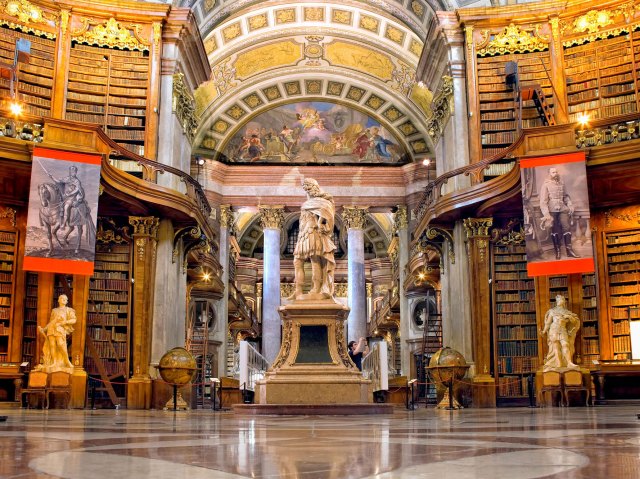
The Austrian National Library — the biggest library in the country — is located in the Hofburg Palace in Vienna. The building once housed emperors and kings, and today serves as the official home for the country’s president and stores over seven million books and documents. One of the handsome, Baroque-style building’s best features is the massive fresco on the ceiling of the stunning State Hall. Created by Austrian artist Daniel Gran, the cupola fresco depicts the deification of Charles VI of France. The domed room is also decorated with statues by sculptor Paul Strudel that honor members of Austria’s Habsburg monarchy over the years.
Beitou Public Library – Taipei, Taiwan
The district of Beitou just north of Taipei City is famous for its hot springs, so it’s only fitting that the Beitou branch of the Taipei Public Library system looks more like a spa than it does a public facility. The building is Taiwan’s first green building, designed to reduce water and electricity consumption. The two-story façade is wrapped with large windows, and the building’s slanted roof is more than a distinct design choice — it helps generate electricity through solar cells and captures rainwater, which is used in the building’s plumbing system.
The Beitou Library’s collection also reflects its ecological purpose — within its 63,000 books is a large collection dedicated to ecological conservation. The natural wooden frame and scenic balconies help the building blend into its natural surroundings.
Bibliotheca Alexandrina – Alexandria, Egypt
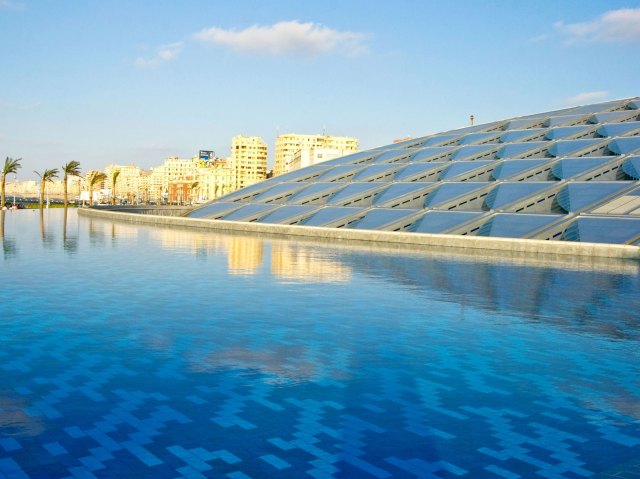
Alexandria was once home to one of the most significant libraries in scholarly history. Now, on the shore of the Mediterranean Sea, the city pays homage to its roots with the stunning Bibliotheca Alexandrina. Designed by Norwegian architecture firm Snohetta, the contemporary building’s circular granite form is key to this tribute, reflecting the cyclical nature of knowledge throughout time.
The exterior walls are carved with over 100 different scripts that honor the human language, while inside, the 11-story structure is illuminated by vertical, north-facing skylights. The grand reading room, with space for more than 2,000 visitors, sits under a welcoming, glass roof, measuring more than 500 feet wide and angled towards the sparkling Mediterranean Sea.
Library of Parliament – Ottawa, Canada
Ottawa’s Library of Parliament, which opened in 1876, originally housed the country’s Parliamentary headquarters. Situated on the banks of the Ottawa River, the Victorian Gothic-style building is known for its oversized, ornate flying buttresses and ornamental ironwork. The interior is characterized by its warm, white-pine paneling, which consists of thousands of intricate carvings of flowers, masks, and mythical beasts.
But the defining feature of the grand room is the white marble statue of Queen Victoria that sits in the center. The stately, Gothic building is so beloved and so recognizable that it was once featured on the Canadian $10 bill. (It was updated in 2018 to feature civil rights activist Viola Desmond, as well as a depiction of the Canadian Museum for Human Rights in Winnipeg, Manitoba.)
UNAM Central Library – Mexico City, Mexico
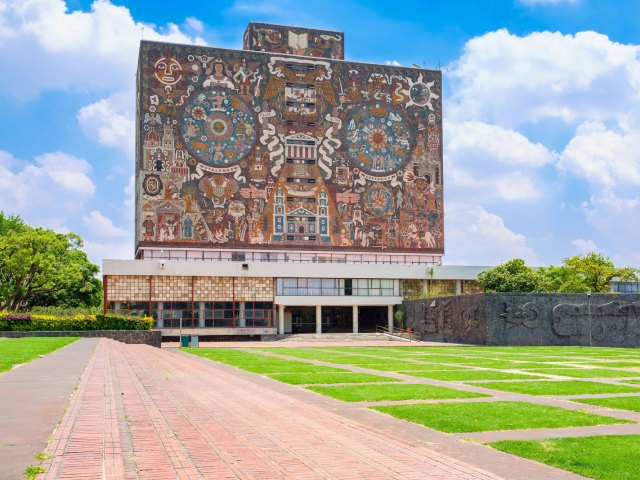
The UNAM Central Library, located on the Ciudad Universitaria campus at the National Autonomous University of Mexico in Mexico City, houses one of the country’s largest collections at over 400,000 materials — and the building itself is also considered a work of art. Its massive exterior mural, created by Mexican architect and artist Juan O’Gorman, takes up the entirety of the 10-story building, telling the visual story of the history of the country.
Although it appears to be a painted work of art, O’Gorman made the mosaic out of brightly colored stones that he sourced from around the country. The base of the building is also made of the volcanic rock upon which it sits — further cementing the building as an intrinsic piece of the country’s culture. In 2007, the building officially became a UNESCO World Heritage Site.
Starfield Library – Seoul, South Korea
You’d be forgiven for mistaking Seoul’s Starfield Library for a bookstore since it was built, rather unconventionally, within a shopping mall. The Starfield Coex Mall is located in the business district of Gangnam and is Asia’s biggest underground shopping mall. The library, designed by the Gensler firm, sits in the center of this subterranean structure; the top floor of its two stories is covered by a glass roof, and four imposing, 43-foot-tall bookcase columns hold the library’s collection of 50,000 books, as well as over 600,000 magazines and journals. With warm natural wood accents and ample natural light, the Starfield is a welcoming cultural and community space in a most unexpected place.
Rampur Raza Library – Rampur, India
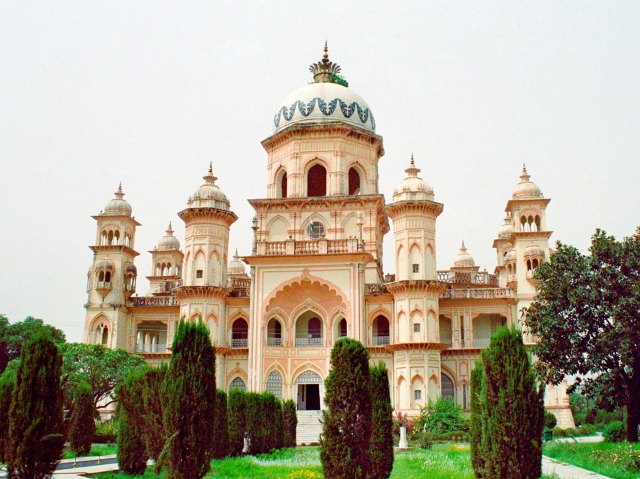
The palatial Rampur Raza Library, located in the northern Indian state of Uttar Pradesh, was originally built in 1904 as a mansion for Nawab Hamid Ali Khan. In 1957, under the last Nawab of Rampur (and the building’s now namesake), Raza Ali Khan, it was converted into the library it is today. The ornate, high-domed and turreted mansion houses an impressive collection; the materials once lived elsewhere and were contributed by the Nawabs of Rampur State over the years.
Rare manuscripts, historical documents, Islamic calligraphy, and even the original manuscript of the first translation of the Qur’an — not to mention the over 60,000 printed books — led to the Raza being named an institution of national importance by the government in 1975.
National Library of Finland – Helsinki, Finland
Although Helsinki’s National Library of Finland originally dates back to 1840, the warmth of its current interior almost gives it a stylish, contemporary flair. The building’s interior and exterior architecture primarily draw from Classicism. Eclectic dashes of decorative Empire-style architecture and Art Nouveau accents alongside the temple-based design make for visual discoveries at every turn.
The National Library is considered one of Finland’s most important cultural spaces, and great efforts have been made to preserve and restore its distinct beauty. Throughout the 2000s, the building’s spectacular ceiling murals and original wooden floors were restored, and an underground book bunker was built to help house the collection of over three million books.
More from our network
Daily Passport is part of Optimism, which publishes content that uplifts, informs, and inspires.






